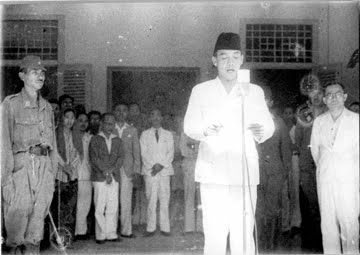Following the Japanese surrender, Soekarno, Mohammad Hatta, and Dr. Radjiman Wediodiningrat were summoned by Marshal Terauchi, Commander-in-Chief of Japan's Southern Expeditionary Forces in Saigon. Soekarno initially hesitated in declaring Indonesia's independence. He and Mohammad Hatta were kidnapped by Indonesian youth groups to Rengasdengklok, west of Jakarta. Finally Soekarno and Hatta declared the independence of the Republic of Indonesia on August 17, 1945.

In the 1950s he increased his ties to the People's Republic of China and admitted more Communists into his government. He also began to accept increasing amounts of Soviet bloc military aid. This aid, however, was surpassed by military aid from the Eisenhower Administration, which worried about a leftward drift should Soekarno rely too much on Soviet bloc aid. However, Soekarno increasingly attempted to forge a new alliance called the "New Emerging Forces", as a counter to the old superpowers, whom he accused of spreading "Neo-Colonialism, Colonialism and Imperialism" (NEKOLIM). His political alliances gradually shifted towards Asian powers such as the PRC and North Korea.
In 1961, this first president of Indonesia also found another political alliance, an organization, called the Non-Aligned Movement (NAM, in Indonesia known as Gerakan Non-Blok, GNB) with Egypt's President Gamal Abdel Nasser, India's Prime Minister Pandit Jawaharlal Nehru, Yugoslavia's President Josip Broz Tito, and Ghana's President Kwame Nkrumah, in an action called The Initiative of Five (Soekarno, Nkrumah, Nasser, Tito, and Nehru). This action was a movement to not give any favour to the two superpower blocs, who were involved in the Cold War.

The Bandung Conference was held in 1955, with the goal of uniting developing Asian and African countries into a non-aligned movement to counter against the competing superpowers at the time. In order to increase Indonesia's prestige, Sukarno supported and won the bid for the 1962 Asian Games held in Jakarta. Many sporting facilities such as the Senayan sports complex (now Bung Karno Stadium), and supporting infrastructure were built to accommodate the games.

In the 1950s he increased his ties to the People's Republic of China and admitted more Communists into his government. He also began to accept increasing amounts of Soviet bloc military aid. This aid, however, was surpassed by military aid from the Eisenhower Administration, which worried about a leftward drift should Soekarno rely too much on Soviet bloc aid. However, Soekarno increasingly attempted to forge a new alliance called the "New Emerging Forces", as a counter to the old superpowers, whom he accused of spreading "Neo-Colonialism, Colonialism and Imperialism" (NEKOLIM). His political alliances gradually shifted towards Asian powers such as the PRC and North Korea.
In 1961, this first president of Indonesia also found another political alliance, an organization, called the Non-Aligned Movement (NAM, in Indonesia known as Gerakan Non-Blok, GNB) with Egypt's President Gamal Abdel Nasser, India's Prime Minister Pandit Jawaharlal Nehru, Yugoslavia's President Josip Broz Tito, and Ghana's President Kwame Nkrumah, in an action called The Initiative of Five (Soekarno, Nkrumah, Nasser, Tito, and Nehru). This action was a movement to not give any favour to the two superpower blocs, who were involved in the Cold War.

The Bandung Conference was held in 1955, with the goal of uniting developing Asian and African countries into a non-aligned movement to counter against the competing superpowers at the time. In order to increase Indonesia's prestige, Sukarno supported and won the bid for the 1962 Asian Games held in Jakarta. Many sporting facilities such as the Senayan sports complex (now Bung Karno Stadium), and supporting infrastructure were built to accommodate the games.



 - SOEKARNO N' FRIENDS
- SOEKARNO N' FRIENDS















